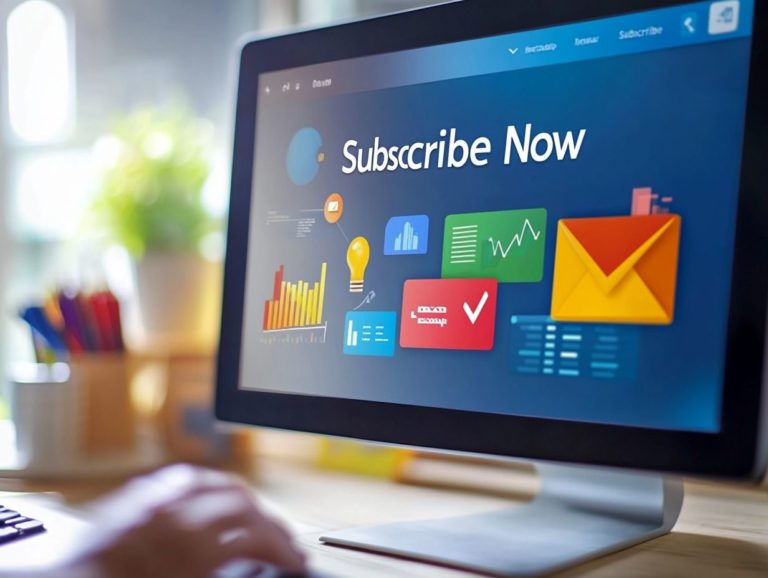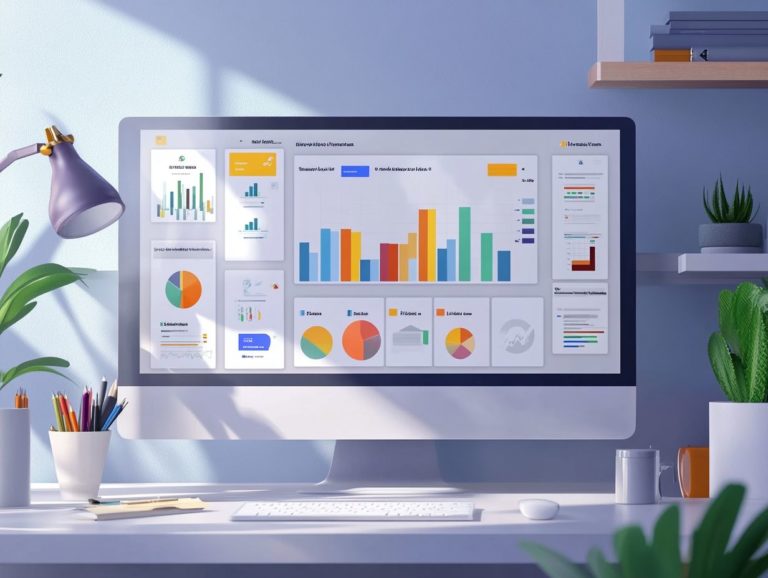Avoiding Spam Filters: Tips for Success
Let's Set Up Your Lead Generation Strategy
Fill out the form below, and our team will get in touch with you to create a tailored solution for your business.
Navigating the world of email can be quite a challenge, especially when ensuring your messages reach their intended recipients.
Spam filters play an important role in this process. Understanding their mechanics and why emails get flagged is essential for effective communication.
This article delves into the details of spam filters, exploring how they work, the common types, and why your emails might end up in the spam folder.
Let s dive in and supercharge your email strategy!
Contents
Key Takeaways:

- Understand how spam filters work and the common types used.
- Be aware of content and formatting issues that can trigger spam filters. Sender reputation and authentication matter!
- Follow best practices for email content and use proper sender authentication.
Understanding Spam Filters
Spam filters are important tools used by email providers like Gmail, Outlook, and Yahoo Mail to protect users from unwanted marketing emails while ensuring a higher deliverability rate. These filters carefully analyze various elements of incoming emails, including sender reputation and spam triggers, to decide whether your email lands in the subscriber’s inbox or the junk folder.
Knowing how these filters work can boost your email marketing strategy and improve engagement rates while keeping your email reputation intact.
How Spam Filters Work
Spam filters analyze incoming emails using various criteria, such as the content of the email, the sender’s information, and authentication measures like DKIM (DomainKeys Identified Mail) and SPF (Sender Policy Framework) records, which help verify if the email is from a trustworthy source.
These mechanisms ensure messages are either delivered to your inbox or directed to the spam folder based on their characteristics. When evaluating email content, filters search for specific keywords, phrases, or patterns commonly linked to spam. They also assess formatting choices, like excessive capitalization or unusual attachments.
The sender’s reputation and domain authentication are crucial; a sender with a record of delivering legitimate content can significantly enhance their standing. This thorough assessment and scoring system help filter out unwanted emails while improving the overall performance and deliverability for those who follow best practices.
Common Types of Spam Filters
Common types of spam filters used by email providers include content filtering, blacklists, and heuristic filtering, each designed to enhance your email deliverability and protect your inbox.
These filters use different mechanisms: content filtering scrutinizes the text of emails for specific keywords and patterns, while blacklists maintain a registry of known spammers, blocking their messages on sight. Heuristic filtering employs advanced algorithms that adapt to emerging spam techniques by assessing the likelihood of an email being unwanted.
While these methods significantly reduce spam volume, they re not perfect; sometimes, genuine emails may be misclassified.
Email providers constantly refine these filters, using machine learning to boost accuracy. By analyzing user behavior and incorporating feedback, these systems evolve, becoming increasingly adept at distinguishing between spam and authentic communication.
Reasons for Emails Being Marked as Spam
Emails can end up in the spam folder for various reasons, including content and formatting issues, the sender’s reputation, and the volume of spam complaints received from users.
Let's Set Up Your Lead Generation Strategy
Fill out the form below, and our team will get in touch with you to create a tailored solution for your business.
These factors can drastically diminish engagement rates and harm the sender’s reputation over time.
Learn how to avoid these pitfalls and improve your email success!
Content and Formatting Issues

Content and formatting issues are common pitfalls that can trigger spam filters. It s essential for you to optimize your email content with engagement-focused features and clear unsubscribe links.
Striking a balance between promotional language and informative content is key. Overusing too much sales language or making inflated claims might raise red flags for spam filters. Instead, focus on providing genuine value, useful information, and well-structured layouts to foster better engagement rates.
A clean design featuring readable fonts, ample white space, and responsive formats will enhance the user experience significantly. Incorporating personalization tokens, which are bits of information that make emails feel tailored to the receiver, can also help create a more tailored experience, encouraging interaction while ensuring you adhere to best practices for compliant messaging.
Sender Reputation and Authentication
Sender reputation and proper email authentication are crucial factors in determining whether your emails land in subscriber inboxes or get relegated to the dreaded spam folder.
To cultivate a positive sender reputation, you need to combine consistent sending practices with low complaint rates and high engagement metrics. It s not a one-time effort; it demands ongoing monitoring and adjustments based on how recipients interact with your emails.
Authentication methods like DKIM (DomainKeys Identified Mail) and SPF (Sender Policy Framework) are essential security measures that help validate your emails and build trust between you and email providers.
These protocols help verify your email s authenticity, significantly reducing the chances of it being flagged as spam. When you implement these strategies effectively, you ll see enhanced engagement rates, ultimately boosting the overall performance of your marketing campaigns. This way, your emails won t just reach the inbox they ll also resonate positively with your audience.
Tips for Avoiding Spam Filters
Want to ensure your emails land in inboxes and not the spam folder? Follow these tried-and-true tips! To enhance your email deliverability and steer clear of those pesky spam filters, you should embrace best practices that revolve around your email content, sender authentication, and meticulous list hygiene.
Prioritizing effective email segmentation can further elevate your strategy, ensuring that your messages reach the right audience with maximum impact.
Best Practices for Email Content
To elevate your email content, prioritize using clear and concise language, personalize your messages, and keep an eye on engagement rates to steer clear of spam triggers.
Crafting compelling subject lines is crucial! They can skyrocket your open rates and catch your recipient’s attention instantly. It s vital to avoid spammy phrases that could land your email in the dreaded junk folder. Tailoring your content to resonate with your target audience not only ensures higher relevance but also fosters a more meaningful connection.
By utilizing permission-based lists, you not only build trust but also maintain compliance with email marketing regulations, enhancing your brand’s credibility and minimizing the risk of penalties.
Let's Set Up Your Lead Generation Strategy
Fill out the form below, and our team will get in touch with you to create a tailored solution for your business.
Ensuring Proper Sender Authentication
Ensuring proper sender authentication through protocols like DKIM and SPF records is vital for safeguarding your email reputation and enhancing deliverability, critical for any email marketing effort.
These mechanisms act as your first line of defense against email spoofing and phishing attempts, protecting both you as the sender and your recipients. DKIM verifies the integrity of your emails during transit, while SPF checks if the sending server is authorized to send emails on behalf of your domain.
By implementing these authentication standards, you can significantly reduce the likelihood of your messages landing in spam folders, thus preserving a strong email reputation. This, in turn, builds trust with your clients and boosts engagement rates, as recipients are much more inclined to open and interact with verified emails.
Tools to Help Avoid Spam Filters

You have access to a range of helpful tools designed to help you navigate spam filters with finesse. Email testing and deliverability tools stand out as essential allies, enhancing the effectiveness of your marketing emails while bolstering your sender reputation.
By leveraging these resources, you can ensure your messages reach their intended audience and make a lasting impact on your email campaigns.
Unlock Your Email’s Potential with Testing Tools
Email testing and deliverability tools offer you invaluable insights into how your emails will perform across various email providers. These tools give you the power to refine your strategies and navigate past those pesky spam filters.
They are essential for monitoring key aspects of your email campaigns, such as open rates, click-through rates, and overall engagement. Options like Litmus and Email on Acid allow you to preview your emails in multiple inboxes, ensuring that your designs look impeccable across different platforms.
Meanwhile, services like Mailchimp and SendGrid provide A/B testing features, allowing you to test different versions of emails to see which one performs better. By leveraging these insights, you can optimize your email performance, ultimately leading to higher conversion rates and a significant boost in ROI.
Email Service Providers with Spam Filter Protection
Choosing the right email service provider can make a huge difference in safeguarding against spam filters and enhancing the deliverability of your marketing emails.
With a plethora of options at your fingertips, it s vital to assess each provider based on their unique strengths in spam filtering technology and tools for engaging users. For instance, platforms like Mailchimp and ConvertKit are renowned for their advanced spam protection features, giving you the power to optimize your campaigns effectively.
Conversely, services such as Sendinblue and Constant Contact provide robust analytics that allow you to measure user interaction, enabling you to refine your strategies with precision. Ultimately, aligning the capabilities of your chosen provider with your email marketing goals not only elevates your campaign s success but also cultivates a more engaged audience.
It’s also important to maintain list hygiene and focus on building permission-based lists to further improve your sender reputation.
Frequently Asked Questions
1. What are some common tips for avoiding spam filters?
Some tips for avoiding spam filters include: using a clear and concise subject line, avoiding excessive capitalization or punctuation, and limiting the number of images or links in your marketing emails. Be mindful to also avoid common spam triggers in your content.
Let's Set Up Your Lead Generation Strategy
Fill out the form below, and our team will get in touch with you to create a tailored solution for your business.
2. How can I make sure my email doesn’t get marked as spam?

To ensure your email doesn’t get marked as spam, use a reliable email service provider, regularly monitor your email deliverability rates, and include a clear unsubscribe link for recipients.
3. Why is it important to avoid spam filters?
Avoiding spam filters is important because if your email gets marked as spam, it may not reach your intended recipients and could damage your sender reputation. This makes it harder for future emails to reach the inbox. Utilizing tools like domain authentication through DKIM (DomainKeys Identified Mail) and SPF records (Sender Policy Framework) can also help.
4. What are some words or phrases to avoid in email subject lines?
Avoid words like “free,” “prize,” and “act now” in your email subject lines. These terms can make your message look like spam and may lower your spam score.
5. How can I personalize my emails without triggering spam filters?
Use the recipient’s name to personalize your emails. But don t overdo it; too much personalization can trigger spam filters.
6. What should I do if my email does get marked as spam?
If your email is marked as spam, act quickly. Review your content for spam triggers and improve your sender reputation. Consider reaching out to the recipient to ask them to whitelist your email address.






